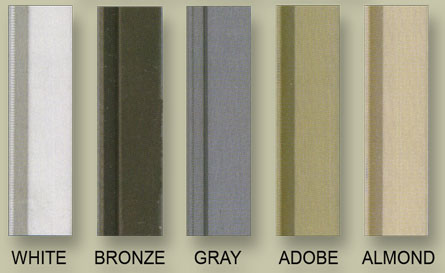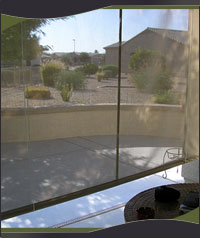In Phoenix Arizona summers Sun Screens are an excellent way to reduce energy consumption, protect interior furnishings as well as control light transmission and glare.
With this in mind we hope the following information will provide some helpful hints to enable you to acquire the most beneficial sun screen, sun shades and roll shades products to suite your specific needs.
Sunscreens are available in two densities, 90% and 80%. Although 90% is the most efficient of the two, it will also reduce considerably the light transmission as well as the air movement through the window on which the Sun Screen has been applied.


- Sun Screens save the average home owner 15% to 20% on their utility bill annually. *1
- Sun Screens pay for themselves approximately every two to three years in energy cost savings.
- Sun Screen fabric materials and frames are available in five colors.
- Sun Screens reduce heat transmission through windows by up to 63%. That’s significant!
- Sun Screens are recommended by most utility providers. Check with your utility provider for rebate programs.
- Sun Screens should last twelve to fifteen years.
- Sun Screens come with five year warranty. *2
*1 Dependant on many variables such as construction type, window type, exposures etc.
*2 Details available through your sales associate.
Save Time and Money:
Although we would be happy to provide you with a free no obligation in home estimate, you can save time and money by simply taking the inside measurements of the windows you would like to address and we can provide you with an estimate within minutes over the phone. We are located in Surprise, Arizona and serve the entire Phoenix Metro area and Arizona.
Technical Talk:
There are many screen products available that claim to provide the aforementioned benefits and most actually do, although the level of performance can differ significantly. Sun Screens as well as most other screen products are comprised of threads that are of a fiberglass/cotton or polyester blend. These blends provide strength as well as resistance to long term exterior exposure. These screen fabrics are available in two basic forms. These forms are referred to as “exposed thread” and “enclosed thread”.
“Exposed thread” screen products; are exactly as the name implies. The threads that these particular types of screen fabrics are comprised of are not protected by any outer coating and therefore are exposed to the environment. The three primary problems with exposure to exterior environments are dust impregnation, sag and premature deterioration. Dust impregnation occurs when dirt and dust particles migrate to the inner fibers of the screen threads, consequently the screen fabric becomes resistant to cleaning and hence becomes unsightly in a short period of time. Sag is when a screen becomes loose in it’s frame and creates rolls or waves in the fabric. This occurs as a result of water saturation as well as dust impregnation. Lastly but most importantly “exposed thread” fabrics deteriorate on the average of five times faster than “enclosed thread” fabrics.
Although these types of screen fabrics require a lower investment to the dealer, the savings are not generally passed on to the customer.
“Enclosed thread” screen products have a coating that surrounds each thread, (polyester in most cases). This thread protection results in a superior screen material that retards dust impregnation and water saturation. Resulting in highly efficient, long lasting screen materials that retain their look and shape and are much easier to clean and maintain. “Enclosed thread” screen products in our estimation should be the only consideration when it comes to Sun Screens.
Obtain multiple estimates. Ask questions. Request samples.
We proudly serve the Phoenix Metro Area and all of Arizona





